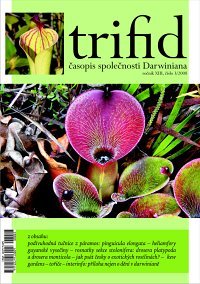Trifid 2008/3
The heliamphoras of The Guayana Highlands
Stewart McPherson (translation by Zdeněk Žáček)
The amazing diversity of the genus Heliamphora is determined by the ecological isolation of „tepuis“ (enormous sandy plateaux). Though the tepuis are very similar to each other climatically, they are locally isolated. The biogeography of The Guayana Highlands is similar to that of ocean islands.
A wonderful butterwort from Páramos
Martin Spousta
The high mountainous regions of Columbia as well as one small area in Venezuela are home to one beautiful butterwort – Pinguicula elongata. Its life is very closely connected to its habitat and therefore in culture its natural conditions are very difficult to imitate (fluctuations of day and night temperatures, constant fresh cool breezes, humidity etc.). Just this fact makes the photos from its habitat yet more valuable. They were kindly provided to the author of this article by H. Hernandez and S. Viera. The article is also illustrated with drawings by professor Jost Casper.
Allen Lowrie's window
Allen Lowrie (translation by Zdeněk Žáček)
A taxonomic revision of the sundews (Drosera) of the Stolonifera section, part II. Following part dealing with the sundews of the Stolonifera section is devoted to descriptions of the following species: Drosera monticola and D. platypoda. D. monticola grows in mountainous regions of the NP Stirling Range and its habitat is from time to time covered with snow. Unlike the former species, D. platypoda is more common in lower altitudes among bushes in heathlands.
How to write about exotic plants in Czech?
Jan Jeník
The renowned Czech geobotanist, professor J. Jeník (one of the honorary members of Darwiniana), mulls over the formation of the Czech botanical nomenclature in this contribution. He gives us some examples of the confusion within Czech nomenclature based on his own knowledge and experience with them. He exhorts a systematic work concerning the formation of our national nomenclature. He says: „I'm sure of an increasing interest in exotic plants in our globalized world, in their cultivation, descriptions and their knowledge. I think this is the real reason for their more familiar names in native languages other than in Latin.“
My visit to the carnivorous plants in the Ralsko upland
Adam Veleba
The author has visited various Czech carnivorous plant localities and has also informed us about them in our journal. This time his attention is directed to the Ralsko Upland and to our rare endemic butterwort Pinguicula bohemica.
How to cultivate the temperate butterworts
Martin Klásek
The temperate species of the Pinguicula genus forming hibernaculas (dormant, „sleeping“ buds) are the main subjects of the author. He describes his experience with their cultivation and he points out possible problems and difficulties.
The peat moss of the Jizera Mountains
Ondřej Sehnoutka
The Jizera Mountains are really rich in peat moss as well as various species of CP's. The author visited several of them. He was greatly surprised when he found the quite unnative Sarracenia purpurea ssp. purpurea among other natural carnivorous plants. It was artificially introduced into the population and has been very prosperous.
Kew Gardens
Jan Franta
Our colleagues, J. Franta and M. Spousta, stayed in Kew Gardens, London for several days during this summer time. Here you have a brief preview through their eyes. Kew Gardens celebrates 250th anniversary next year and there are a lot of interesting plants and other things worthy of your attention, literally: in every square meter of the 120 hectares. Go there, you must experience it for yourself!
The plant with a bad name
Miloslav Studnička
This is a peculiar narrative from the director at The Botanical Garden in Liberec (our honorary member also). He studied a beautiful tillandsia (T. caput-medusae) in its natural surroundings of Veracruz in Mexico. The question is, why is this species named after the Greece deity, when there are many deities in Mexico itself? We should name it Kukulkan's Tillandsia (T. cuculcana) for example.
The orchids of the Ophrys genus – the orchids offer only sex (no food, just sex)
Andrej Pavlovič
These orchids developed a unique strategy to attract their pollinators. They don’t attract them by offering sweet nectar, as is common in the plant world, but by offering sex. Pollinators land on their flowers for the main purpose of copulating. Well, food and sex are basic instincts not only for humans.
The Mirek Zacpal's Australian diary: Drosera peltata
Mirek Zacpal
Mirek Zacpal, our member and volunteer reporter in Australia, describes more findings on sundews. This time he discovered an abundant population of Drosera peltata in The Royal National Park. All was photographed and documented appropriately.
